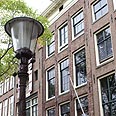
Holland: New info on Jews' WWII arrests
Netherlands' national archive says data will reveal to some Dutch Jews the names of those who arrested their relatives, other facts about their final days
The information, from a sealed archive on wartime collaborators, will reveal to some Dutch Jews the names of those who arrested their relatives and other precious facts about their final days as they were deported to Nazi concentration camps during the German occupation of the Netherlands from 1940 to 1945.
The project was carried out by journalist Ad van Liempt and a team of researchers who received special permission in Sept. 2010 to review dossiers of 250 collaborators who are no longer alive.
It primarily centers on the work of the "Henneicke Column" – a group of Dutch Nazi collaborators working in the investigative division of the government's Central Bureau for Jewish Emigration, which employed police and bounty hunters to find Jews who had escaped the net of the Nazis and their informers.
While researching a book on the bounty hunters in 2002 – "A Price on Their Heads" – Van Liempt found personal information in the archive he thought would be useful to victims, but knew they would be unable to obtain.
There are 500,000 dossiers on 310,000 collaborators at the archive's collection on special postwar tribunals, but those records are sealed until those named inside have died – and even then they can only be viewed by family members or victims.
In addition, the archive is organized by collaborator name, rather than by victim, making it harder for relatives to know where to look. The new information is just a fraction of what the sealed archive contains.
"None of the victims knew who had arrested them, or they weren't able to communicate it" before they died, Van Liempt said in an interview published on the website of state broadcaster NOS.
110,000 Dutch Jews died in Holocaust
One Jewish survivor contacted by the project is Paul Hellmann, whose father Bernhard died at the Sobibor camp in Nazi-occupied Poland. Researchers found a dossier in the archive containing previously unknown details of Bernhard's arrest on a Dutch farm where he was hiding, and his subsequent interrogation.
Also contained in the same dossier were two letters written by the then 7-year-old Paul, in a schoolboy scrawl, to his father. They had been delivered to the farm by someone in the Dutch resistance and Bernhard was carrying them at the time of his arrest.
"I couldn't believe my eyes. I couldn't look at them at first, and then later I did," Paul Hellmann said in an interview with NOS.
The letters were about everyday occurrences such as seeing trams in the eastern Dutch city of Arnhem, and eating a tasty pie, "but they are letters from a son to his father" Hellmann said. "It's one of the cruelest things that they did, that he wasn't allowed to keep those letters."
Results of the project announced Tuesday will only be available to victims' families. The names of the 9,000 victims will be added to a digital database later this month.
An estimated 110,000 Dutch Jews died in the Holocaust, including teenage diarist Anne Frank. Just 30,000 Dutch Jews survived the war.
Details of the Frank family's arrest are already known, although it remains uncertain who tipped police to her family's hiding place above a canal-side warehouse in Amsterdam.
- Follow Ynetnews on Facebook










